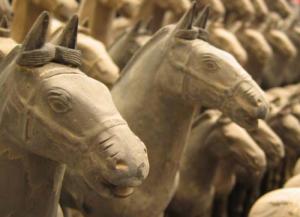
Research points to early castration
A Chinese archeologist has revealed that most of the clay horses unearthed from the mausoleum of Qinshihuang were castrated.
Archeologist Yuan Jing studied more than 600 of the life-size statues in the terracotta army located on the outskirts of Xi’an, in the Chinese province of Shaanxi. All 520 chariot horses were geldings, having penises but not testes. That varied in the 116 cavalry horses, however, where some were geldings and others were stallions.
“The new finding will help our research into how once unruly horses were tamed by humans and played a role on the battlefield,” Yuan said. “It might also help to unravel more secrets about the terracotta army.”
Research of ancient horse remains, however, needs to be undertaken before any conclusions can be made about whether or not living horses were castrated.
The oldest written descriptions of castrating pigs date back over 3000 years, indicating that “castration of animals was prevalent more than 2,000 years ago,” said Yuan.
